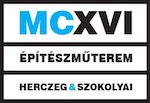| Location | Szentendre |
| Client | Directorate of Museums in Pest County |
| Floor area | 21 000 m2 |
| General design | MCXVI Architects |
| Leading architect designer | László Herczeg |
| Architect designers | Orsolya Almer, Mariann Szőke |
| Project phase | Design competition, 3rd Prize |
| Project year | 2012 |
ULCISIA CASTRA, DESIGN COMPETITION
The aim of the open international design contest is to preserve the Roman remains of Szentendre to make it accessible to tourists in a museum environment.
The museum was connected with the town with disciplined, orderly vineyards. Among the rows we use gardening coverings (railway sleepers, dumbbells, wooden pegs, etc.). We keep the preciousness of the area’s buildings and create clean spaces around them. New features include exhibition space, restaurant, wine cellar, mainly tourist service. The wine cellar of the Paprikabíró Street is revitalized.
Those large areas of the building that does not require natural light were placed below the surface. The planned surface structures take up the intermediate scale of Szentendre and the city. Each wing closes urban spaces – open park – closed open square – closed museum park. The upgraded office building closes the installation as a sign of the road. From the west, a multiple filter zone protects the spaces between the museum – a rich grove – fenced structure – a gateway to the main square covered with a wing. The deep-level garage of the city is completely separated from the museum building and can be constructed independently. Buses can park on the recessed floor, on the surface.
Internal design – functional connections:
The museum opens from the main square. The permanent exhibition of art is in the centre of the building under the surface. Visitors walk through the two-story square into the lobby area. Here we placed the cloakroom, some of the shops, and the cafe. From here there is the upper level of the temporary exhibition space, which can be connected to the floor with the permanent exhibition space. The permanent exhibition of art’s interior has a basilical shape, at one point it is illuminated from the main square. The central wing can be accessed separately of the first floor conference room. The local history exhibition and the Ferenczy collection were placed at the top of the museum. The rooms for museum pedagogues are located in the northern part of the building. Each one opens to the museum garden. At the ground floor of the eastern and western wings, the public relations department and the archaeological exhibition were placed. We opened the archaeological exhibition to the excavation area. The exhibition halls can be divided with shutters and curtains. Positioning of the supporting structure designates the traffic lanes that can be arranged during the rearrangements, at the end of the locks. The spaces can be completely draped from the facade, but filtered lightning is also possible.
The offices of the building were placed in a separate building. The house is in connection with the museum under the surface. It is also accessible from the terrain and the museum. The library and library-researchers are on the ground floor. Various offices were arranged on four levels, according to functions.
On the facades we mixed 3 materials: glazed ceramic grid, rough plaster and glass. The stratification of the three materials gives the boundaries of the different functional spaces.

